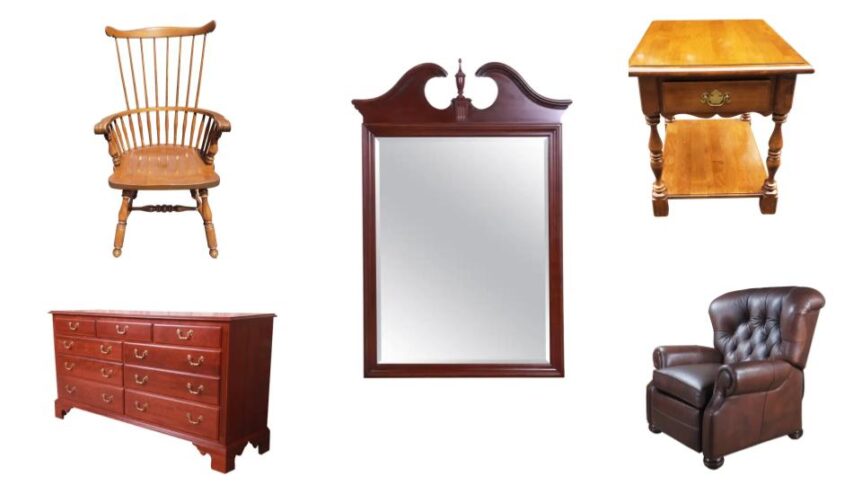Everything you need to know to find out if your Ethan Allen furniture is vintage.
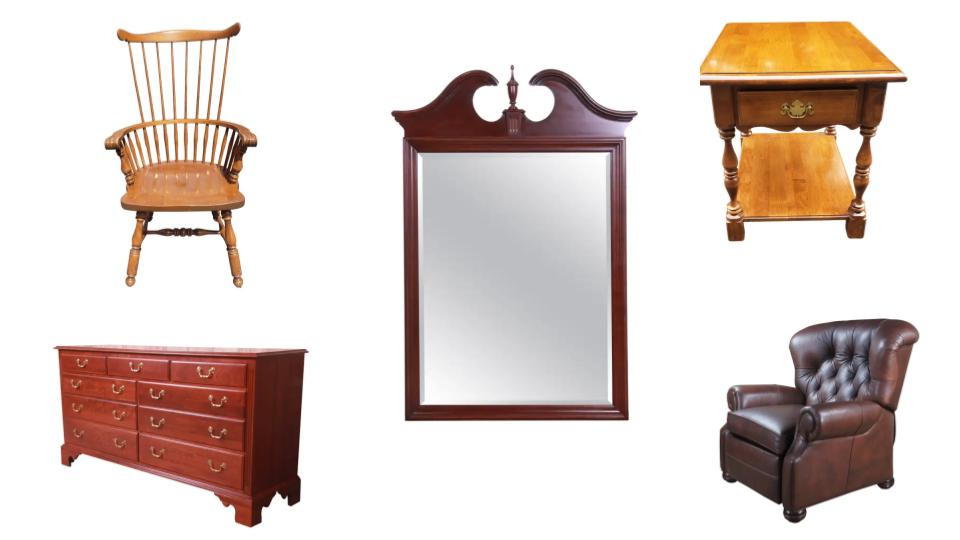
Ethan Allen is one of America’s most beloved and well-known furniture brands. Since its founding in 1932, Ethan Allen has produced countless high-quality furniture collections spanning a wide range of styles from Early American and Colonial Revival to 18th-century reproductions and mid-century modern chic.
While Ethan Allen continues manufacturing furniture today, vintage pieces from the mid-20th century through the 1980s have become coveted collector’s items. The vintage Ethan Allen aesthetic is prized for its timeless styling, thoughtful designs, high-end materials, and expert craftsmanship.
But with thousands of furniture lines produced over multiple decades, identifying true vintage Ethan Allen pieces can pose a challenge. Clever reproductions and “vintage-inspired” collections make it easy for buyers to be duped. Luckily, arming yourself with the knowledge of what details to examine can help you successfully spot the real deals.
Some of the main ways to identify vintage Ethan Allen furniture include examining the manufacturer’s marks, construction methods, materials used, and overall design style. Looking closely at these elements can reveal if a piece is a genuine vintage product versus a newer version or another furniture brand name.
This comprehensive guide will walk you through techniques for properly identifying vintage Ethan Allen furniture based on labels, design eras, materials, construction methods, and model names. With a trained eye and the tips below, you’ll be able to hunt down authentic vintage Ethan Allen gems at antique malls, estate sales, auctions, and secondhand shops.
A short history of Ethan Allen furniture
Ethan Allen is an American furniture chain with about 300 stores across the United States, Canada, Europe, the Middle East, and Asia. The company was founded in 1932 by two brothers-in-law, Nathan S. Ancell and Theodore Baumritter, as a housewares manufacturer.
They bought a bankrupt furniture factory in Beecher Falls, Vermont in 1936 and adopted the name “Ethan Allen” after the Revolutionary War Hero from Vermont. In 1939, at the Chicago Housewares Show, Ethan Allen debuted a 28-piece line of colonial-style furniture, which was named after Ethan Allen.
The company officially changed its name to Ethan Allen in 1969 and began marketing directly to consumers rather than to furniture retailers.
As of 2020, Ethan Allen has 304 design centers domestically and abroad, nine manufacturing facilities in the United States, Mexico, and Honduras, and 14 retail delivery centers located across the United States and Canada. The company makes customized furniture domestically, such as upholstered furniture, sofas, and chairs, custom-made in a selected fabric.
How to Identify Vintage Ethan Allen Furniture
Examining Labels, Markings & Date Codes
One of the most reliable starting points for identifying vintage Ethan Allen pieces is to look for any labels, tags, stamps, or markings that provide clues to the era of production. Here’s what to search for:
Maker’s Marks
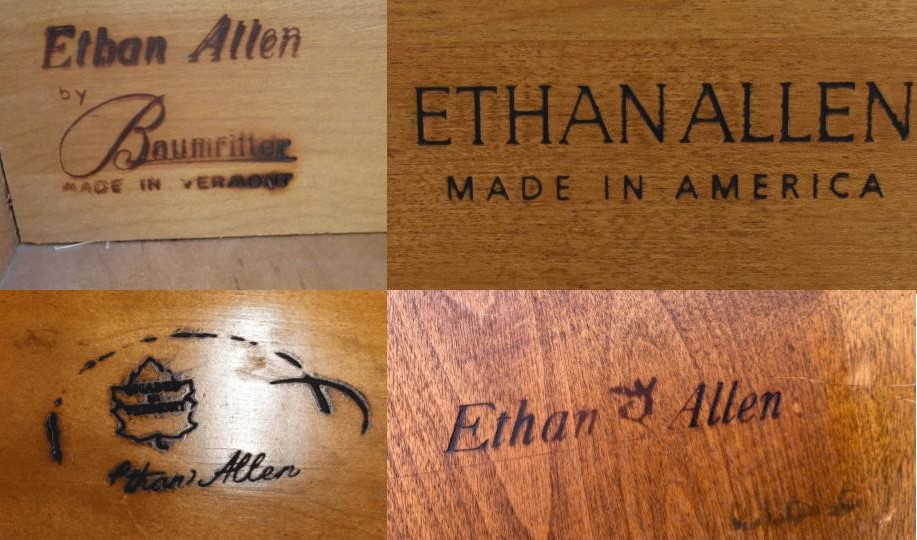

The easiest way to identify Ethan Allen furniture is to look for the maker’s mark stamped or printed somewhere on the piece. Some of the main makers you will see on vintage Ethan Allen furniture during the 1950s and 60’s include:
- Ethan Allen
- Ethan Allens Amercias Traditional
- Ethan Allen by Baumritter
- Ethan Allen with maple tree motif
- Ethan Allen with motif in the middle
Modern iterations of the Ethan Allen logo include “Ethan Allen made in America”
Other Stamps
Aside from the maker’s marks above it is also worth looking out for other company names or variations of the Ethan Allen brand on vintage furniture. The use of particular company names can offer insight into the era when the piece was manufactured, with certain names having associations with specific periods in furniture history.
- Baumritter Corporation: This name harks back to the early years, symbolizing an era of craftsmanship and design that characterized a specific time frame.
- Ethan Allen: Recognized as a well-established furniture brand, the presence of “Ethan Allen” suggests that the piece might hail from a period when the company was known for its particular design aesthetics and production techniques.
- Ethan Allen Industries: This name signals another phase in the company’s evolution, possibly indicating a shift in manufacturing practices or a broadening of its product line.
- Ethan Allen Interiors: A name like “Ethan Allen Interiors” could point to a specific era when the company was emphasizing interior design and lifestyle concepts alongside its furniture offerings.
- Ethan Allen, Inc.: The use of “Ethan Allen, Inc.” might hint at the company’s transition to a corporate structure, which could correspond to a particular period of its history.
- Green Mountain Holding Corporation: This name introduces yet another layer of historical context, suggesting that the piece may have been crafted during a time when corporate ownership structures were evolving.
- Interco: The appearance of “Interco” on the stamp might be indicative of a period when the furniture industry was undergoing changes in ownership or consolidation.
By paying attention to the company names stamped on furniture, collectors, and enthusiasts can embark on a fascinating journey through time, unraveling the evolution of design trends and the shifting landscapes of the furniture manufacturing industry. Each of these names, though seemingly straightforward, holds a wealth of historical information waiting to be discovered and appreciated.
Serial Numbers
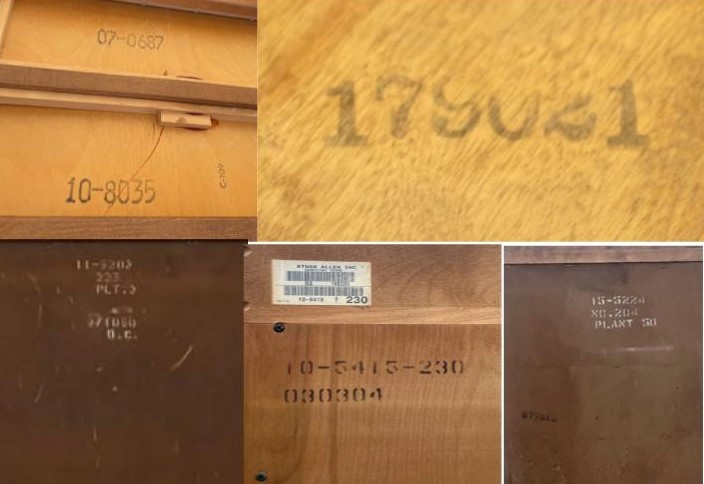
If you inspect closely some Ethan Allen’s furniture should have serial numbers on them. These can sometimes be worn and faded and hidden on the underside of drawers or within the main construction.
Some serial numbers to look out for include:
- 07-0678
- 10-8035
- 179021
- 11-5203
- 15-5224
Consulting detailed Ethan Allen archives, collectors can often match these serial numbers to specific product lines and manufacturing details based on the year and sequence. The best way to do this is by calling Ethan Allen customer service at 1 (888) 324-3571 and ask if they can identify the serial numbers.
Identifying by Design Style
In addition to markings, understanding the distinct design eras of vintage Ethan Allen furniture is an indispensable skill for proper identification.
The company’s furnishings evolved through specific style phases across the 20th century, ranging from Colonial Revival to 18th Century reproductions. Become familiar with these vintage aesthetics and key traits:
Early American (1932-1950s)

Ethan Allen’s earliest furniture drew inspiration from classic Early American colonial styles including Chippendale, Queen Anne, Appalachian and Shaker influences. These pieces have simpler lines with lighter wood tones in pine, maple and fruitwood finishes. Identifiers of Early American style include:
- Tall poster beds with turned posts
- Blanket chests or toy chests
- Farmhouse style trestle dining tables
- Classic Windsor or ladder back chairs
- Double pedestal secretaries desks
- Low open hutch cabinets
This pioneering Ethan Allen style remained popular even as new lines were introduced, reflecting an enduring consumer appetite for classic colonial furnishings.
Colonial Revival (Mid-Late 1950s)
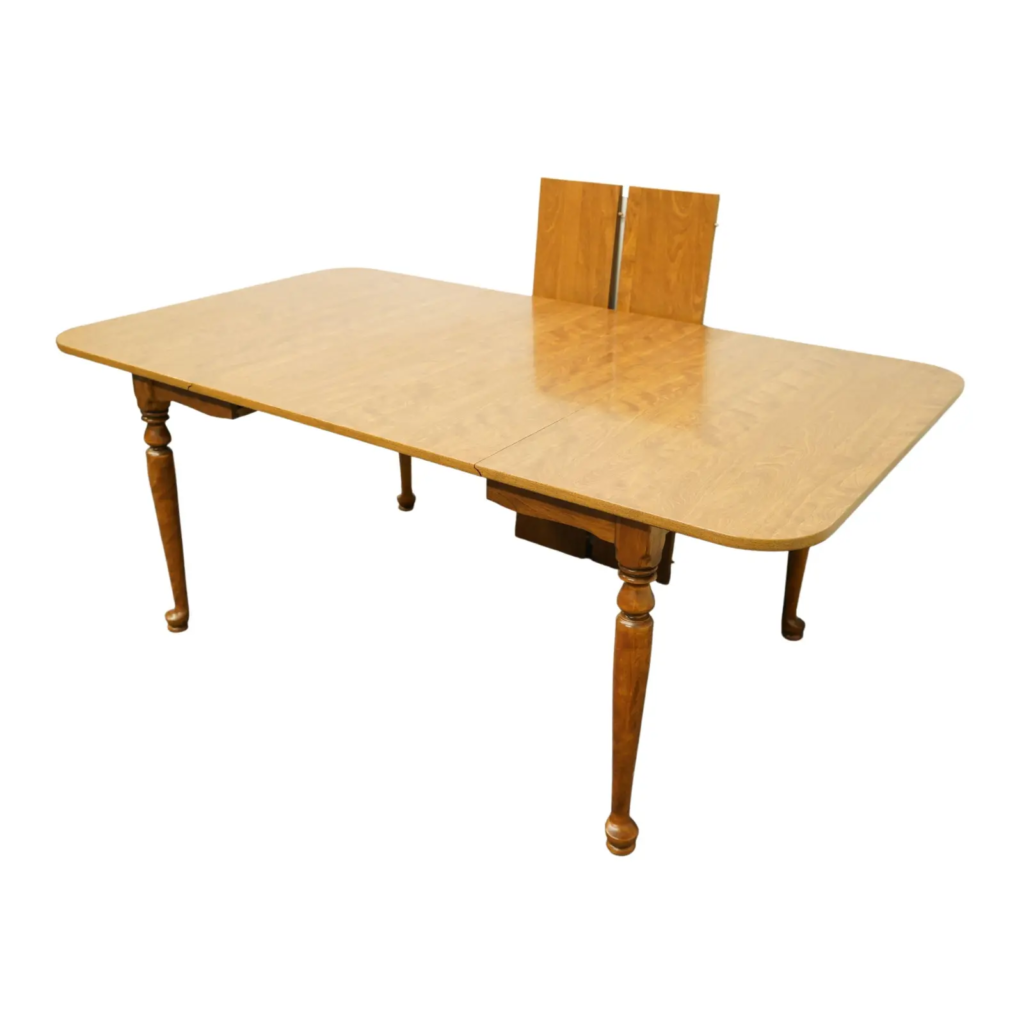
Post-WWII, Ethan Allen captured the Colonial Revival spirit prominent in the 1950s-60s. This style presented early American furniture forms updated with new materials, finishes, and functionality.
Colonial Revival maintains the early American influence but with these defining traits:
- Darker wood tones in cherry, mahogany and walnut
- Turned spindle legs on case goods
- Inlaid wood accents
- Chip carving and banding details
- Blocky nailheads trimming upholstered chairs
- Classic serpentine fronts on dressers and chests
- Coffee tables on gently cabriole legs
Ethan Allen collections like the 1957 280 Dining Group typify the brand’s take on Colonial Revival design.
18th Century Reproductions (1960s-1970s)

Ethan Allen expanded greatly in the 1960s and 70s, becoming renowned for exquisitely crafted reproductions of 18th century English, French and early American antique furnishings. Characteristics of this era include:
- Intricate hand-carved cabriole legs
- Carved aprons and feet
- Inlay marquetry and intarsia motifs
- Scalloped and serpentine shaping
- Ornate brushed brass hardware
- Claw and ball feet
- Caned and upholstered backs and seats
Famed collections from this period include the late 1960s Fontainebleau bedroom and dining groups, drawing inspiration from Louis XV French antiques.
Identifying by Material
The specific wood species and hardware styles used can provide valuable clues to authenticate vintage Ethan Allen manufacturing. Here are the most common by era:
Woods
- Mahogany – Used heavily from the 1940s-70s. Rich reddish brown tones and distinctive grain patterns.
- Cherry – Grows in popularity in the 1950s-60s. Similar red tones to mahogany but with characteristic flowing grain.
- Maple – One of Ethan Allen’s earliest woods. Prized for its blond, sometimes curly grain.
- Walnut – Seen in higher-end 18th century reproductions for its rich chocolate hues.
- Pine – Ethan Allen’s budget friendly lines often relied on pine, noted for its rustic knotty imperfections.
- Teak – A favorite of mid-century modern designers; golden brown color and noticeable grain.
Hardware
- Wrought iron – Black metal used for legs and accents in Early American lines. Rustic forged appearance.
- Brass – Common from the 1950s-1970s. Often mellowed into an antique brass patina over time.
- Pewter – Employed for handles and pulls on 18th century reproductions. Distressed silver coloring.
- Chrome – The sleek shiny hardware seen on mid-century and modern inspired designs.
High-quality hardware in good surviving condition can indicate careful use and storage of vintage Ethan Allen finds.
Examining Construction Methods
Skilled Ethan Allen craftsmen working in each era used specialized joinery and construction techniques that can help identify truly vintage manufacturing. Look for these indicators:
Joinery
- **Mortise and tenon – ** A hallmark of Ethan Allen’s quality is mortise and tenon joinery, used to strongly join frame and case pieces. Interlocking wood joints secured with glue. Common in 18th century reproductions.
- Dovetail joints – Interlocking “fingered” joints used to assemble drawers. Shows high quality craftsmanship in real vintage furniture.
- Butt joints – Plain angled joints secured with nails and glue. A quicker and cheaper technique seen in budget minded lines.
Drawers
- Solid hardwood – Highest end case goods and dressers will have full wooden drawer boxes.
- Dovetailed fronts – Dovetail joints on the front to show off craftsmanship, but simpler plywood sides and back. A durable hybrid approach.
- Plywood – Lower cost Ethan Allen lines relied solely on plywood for the full drawer box construction.
Cheap plywood or composite woods like particle board indicate a newer piece emulating vintage style.
Related articles:
- How to Identify Authentic Charles Eames Chairs
- How To Identify Vintage Henredon Furniture
- Drexel Heritage Furniture: A Guide to One of the Vintage Icons
- Saga, Sculptra & Brasilia: A Guide To Vintage Broyhill Furniture
Determining solid wood vs. veneers
As Ethan Allen expanded manufacturing, their furniture incorporated more veneers, laminates, and engineered wood products to increase efficiency. Examining the materials used can provide clues to a piece’s age:
Identifying solid wood
- Heavier in weight than veneered products
- Joined corners will show end grain on table legs, for example
- Dovetailed joinery is often present
- Resists scratches, gouges, and dents compared to veneers
- Wood graining appears more natural and flows smoothly
Signs of veneers
- Lighter weight construction
- Edges reveal laminate or particle core material under veneer
- Wood grain may appear more uniform or repetitive
- Surfaces prone to scratches or irregular dents
- Less veneer on undersides and rear surfaces
On higher-end vintage pieces, exposed surfaces like tabletops or cabinet doors may be solid wood while side panels and interior bracing utilize quality plywood veneers. Examining joinery, weight, finish quality, and edging materials provides clues to age and construction methods.
Where to sell authentic vintage finds
For sellers, verified vintage Ethan Allen can command a premium in today’s market. Here are top options for profiting from vintage finds:
Online Marketplaces
eBay, Etsy, Chairish and 1stDibs have built-in vintage buyers. List with detailed descriptions highlighting hallmarks of vintage craftsmanship and any unique attributes. Market to dedicated Ethan Allen collectors on brand-specific forums and groups.
Consignment Shops
Consign vintage Ethan Allen pieces through reputable consignment stores and antique retailers. Shops located in affluent areas tend to gain high visibility among buyers attracted by the Ethan Allen name and styling. Provide serial numbers or manufacturing facility marks to validate authenticity.
Estate Sales
Ethan Allen furniture performs well at estate sales, since the brand is trusted and has broad appeal. List sales on websites like EstateSales.net where vintage collectors and mid-century enthusiasts frequently search for treasures.
Local Listings
Facebook Marketplace, Craigslist, and newspaper classifieds list items available locally. Take detailed photos highlighting craftsmanship details for buyers to self-verify authenticity. Offer in-person inspections.
Maximizing value
To obtain top dollar, restore any finish damage or upholstery wear while preserving vintage hardware and design elements. Note rare attributes like original upholstery fabric or unique options like custom finishes. Properly restored vintage Ethan Allen in maple, oak or teak can return significant value for invested effort.
Identifying Authentic Vintage Ethan Allen – Key Takeaways
When evaluating potential vintage Ethan Allen finds, look beyond just the style details which can be easily mimicked in newer furniture. Focus on these key authenticators:
- Labels/markings – Search for properly era-specific maker’s marks, paper labels, date stamps or serial numbers that match vintage production periods.
- Wood species – Mahogany, cherry, maple and walnut suggest genuine vintage construction. Avoid particle board and manufactured wood products.
- Joinery – Quality mortise and tenon joints along with dovetailed drawers indicate true vintage craftsmanship.
- Model names – Hunt down headboards, chests and cabinets bearing labels from popular mid-century collections to find prized pieces.
Training your eye using these authentication tips will help you successfully hunt down vintage Ethan Allen treasures while avoiding costly forgeries or reproductions.
Now get out there and check your local antique malls, estate sales, online auctions and secondhand stores to secure authentic mid-century Ethan Allen furnishings for your own collection!

